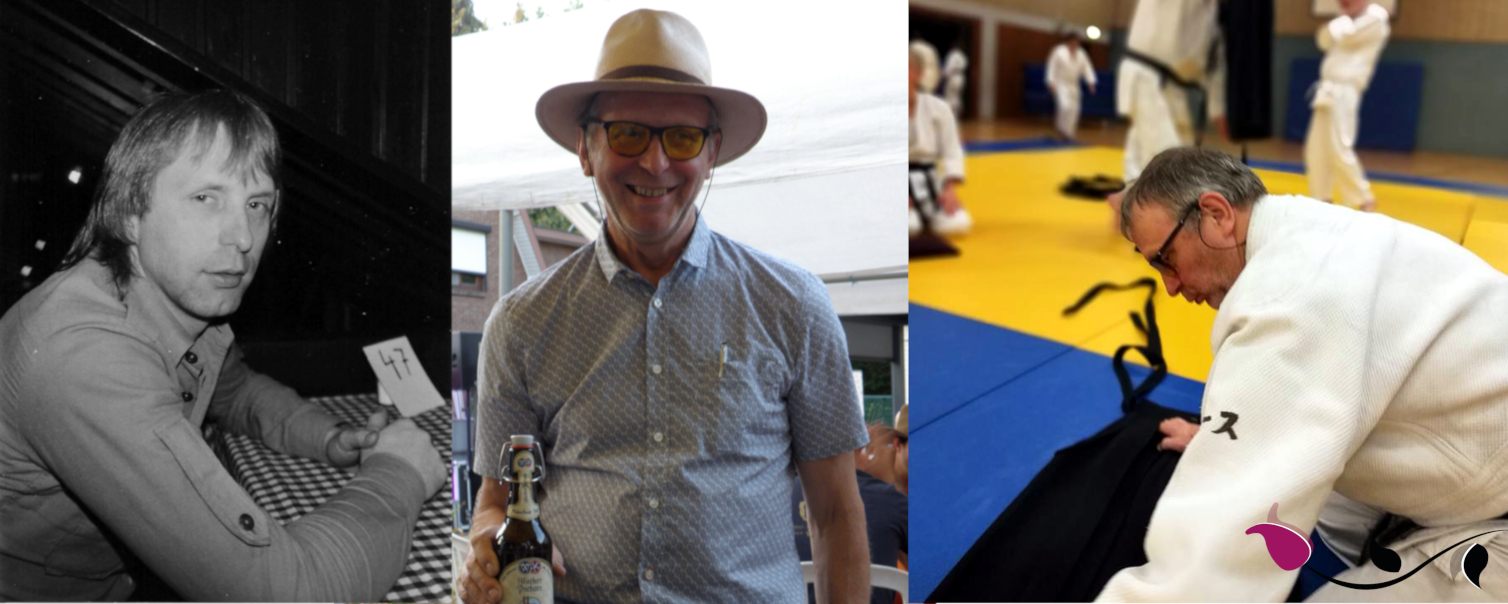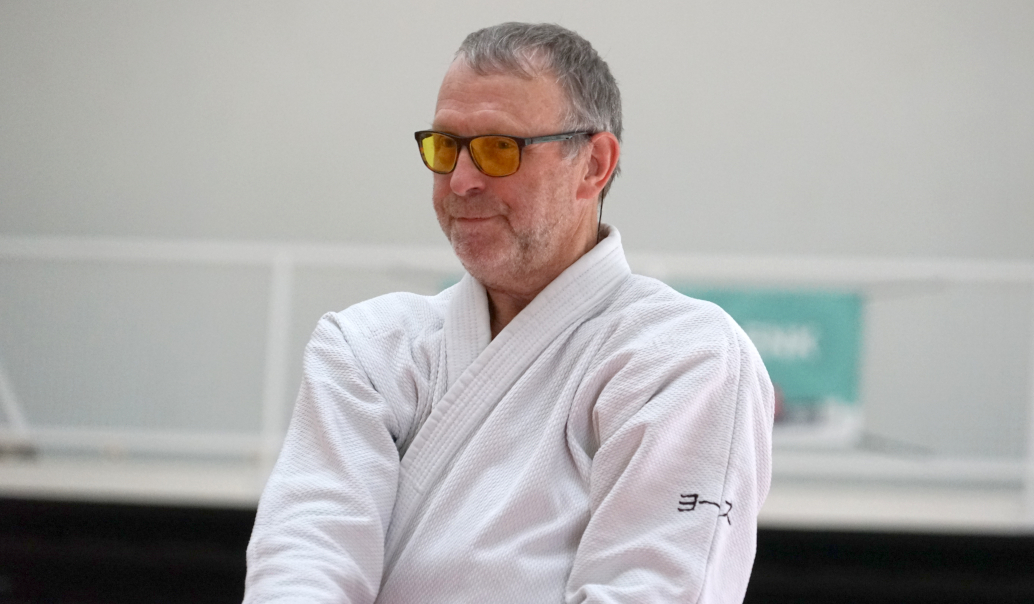Some words, expressions, courtesies, etc. that are frequently used during training and seminars.
|
JAPANESE |
MEANING |
SPELLING |
|
onegaishimasu |
if you please |
お願いします |
|
hajime |
begin (let's begin) |
始め |
|
soremade |
heretofore, stop |
それまで |
|
yame |
stop, finish |
止め |
|
domo arigato gozaimasu |
thank you |
どうも有難う御座います |
|
do itashimashite |
you're welcome, my pleasure |
どういたしました |
|
shizentai |
natural posture, natural stance |
自然体 |
|
kama’e |
stance, posture |
構え |
|
seiza |
correct kneeling |
正座 |
|
suwari waza |
techniques performed kneeling |
座り技 |
|
hanmihan dachi |
nage kneels, uke is upright |
半身半立ち |
|
tachi waza |
techniques performed upright |
立ち技 |
|
hidari |
left |
左 |
|
migi |
right |
右 |
|
omote |
front side, in front |
表 |
|
ura |
back side, along the back (dorsal) side |
裏 |
|
kaiten |
rotation, spin |
回転 |
|
irimi |
step in (with your body) |
入り身 |
|
tenkan |
turn around, veer, change stance, backwards |
転換 |
|
taisabaki |
turn of the body |
体捌き |
|
tai no henka |
turn of the body from ‘gyakuhanmi katate dori’ position |
体の変化 |
|
ayumi ashi |
step, change step |
歩み足 |
|
suri ashi |
sliding stepping movement |
摺り足 |
|
aihanmi katate dori |
seizing the hand from the samen basic stance |
相半身片手取り |
|
gyakuhanmi katate dori |
seizing the hand from a mirroring basic stance |
逆半身片手取り |
|
morote dori |
the uke seizes with both hands one of the nage's hands (‘katate ryote dori’) |
諸手取り |
|
ryote dori |
the uke seizes both the nage's hands |
両手取り |
|
sode dori |
seizing the arm or the forearm |
袖取り |
|
hiji dori |
seizing the elbow |
肘取り |
|
mune dori |
seizing the lapel |
胸取り |
|
kata dori |
seizing one shoulder |
肩取り |
|
kata dori men uchi |
seizing one shoulder, followed up by a straight strike at the head with the other hand |
肩取り面打ち |
|
chudan tsuki |
thrust with the fist at the stomach |
中段突き |
|
shomen uchi |
a straight strike with the hand tot the top of the head, from top to bottom |
正面打ち |
|
yokomen uchi |
oblique (slanting) strike at the head |
横面打ち |
|
eri dori |
seizing the collar |
襟取り |
|
ushiro eri dori |
seizing the back side of the collar |
後ろ襟取り |
|
ushiro kubi shime |
strangle from behind |
後ろ首閉め |
|
ushiro ryokata dori |
seize both shoulders from behind |
後ろ両肩取り |
|
ushiro ryote dori |
seize both wrists from behind |
後ろ両手取り |
|
ukemi |
passive movement of the body (by falling, by having you guided) |
受け身 |
|
mae ukemi |
exercise to train forward fall (roll forwards) |
前受け身 |
|
zempo kaiten |
exercise to train forward fall (advanced roll) |
前方回転 |
|
ushiro ukemi |
exercise to train backwards fall (roll backwards) |
後ろ受け身 |
|
koho kaiten |
exercise to train backwards fall (rearward facing roll) |
後方回転 |
|
yoko ukemi |
exercise to fall sideways (sideways roll) |
横受け身 |
|
tobi ukemi |
exercise for free fall („flying fall”) |
飛び受け身 |
|
budo |
way of the martial arts (road, the way to find yourself) |
武道 |
|
aikido |
way of the harmony (‘aiki no michi’) |
合気道 |
|
o sensei |
‘Ueshiba Morihei sensei’ (biggest teacher) |
大先生 |
|
Tendoryu aikido |
aikido style (school, direction) Tendo (‘Shimizu Kenji sensei’) |
天道流合気道 |
|
rei |
grattitude, respect, courtesy |
礼 |
|
jin |
humanity, love of one's fellow man, benevolence, consideration |
仁 |
|
yuki |
courage, valour |
勇気 |
|
makoto |
sincerety, honesty, sense of reality |
誠 |
|
shinken |
seriousness, earnestness, genuine attension |
真剣 |
|
shoshin |
beginner's mind |
初心 |
|
awase |
harmonise |
合わせ |
|
nagashi |
stream, flow |
流し |
|
junansei |
ability to addapt, flexibility, pliancy, ability (possibility) to accompany (come along) |
柔軟性 |
|
kuzushi |
disrupt balance (equilibrium) |
崩し |
|
ma’ai |
distance, bearing (posture, relation) to one another (harmonic space, area) |
間合い |
|
keiko |
training of Budo (repeat the past) |
稽古 |
|
renshu |
exercise, training in general |
練習 |
|
kokyu ho |
breathing technique, control of respiration |
呼吸法 |
|
iki o haku |
breath out (abandon one's breaht) |
息を吐く |
|
iki o su |
breath in (pick up one's breath) |
息を吸う |
|
sensei |
teacher, master, professor (the earlier born) |
先生 |
|
waka sensei |
young teacher, maste |
若先生 |
|
shidosha |
certified trainer in the global organisation (TWA) |
指導者 |
|
sempai |
elderly student |
先輩 |
|
deshi |
student |
弟子 |
|
nage |
throwing (also ‘shite’) => target, aim of the ‘uke’ |
投げ |
|
shite |
leading hand (also ‘nage’) => leading, guiding of ‘aite’ |
仕手 |
|
uke |
receiving, passive (also ‘aite’) => undergoes the action taken by ‘nage’ |
受け |
|
aite |
opposite, converging hand (also ‘uke’) => partner of ‘shite’ |
相手 |
|
shiho nage |
four directions throw, sword throw |
四方投 |
|
irimi nage |
throw while stepping into the center |
入り身投げ |
|
kote gaeshi |
throw while twisting the wrist (literally: giving back the forearm) |
小手返し |
|
atemi waza |
technique to accompany the partner with a thrust that doesn't hit |
当身技 |
|
hazushi waza |
techniques to free oneself from the grip of the attacker |
外し技 |
|
katame waza |
techniques to pin down, to restrain (‘osae waza’) |
固め技 |
|
ikkyo |
first control technique (=>’ude osae’) |
一教 |
|
ude osae |
control technique (ikkyo) restraining the whole arm |
腕押え |
|
nikyo |
second control technique ( => ‘kote mawashi’) |
二教 |
|
kote mawashi |
control technique (nikyo), with inward twisting of the wrist |
小手回し |
|
sankyo |
third control technique (=> ‘kote hineri’) |
三教 |
|
kote hineri |
control technique (sankyo), with inward twisting of the forearm |
小手捻り |
|
yonkyo |
fourth control technique (=> ‘tekubi osae’) |
四教 |
|
tekubi osae |
control technique (yonkyo) to restrain the wrist by pressure on a nerve |
手首押え |
|
sutemi waza |
sacrificing throw |
捨て身技 |
|
henka waza |
technique in which one changes direction |
変化技 |
|
kaishi waza |
taking over, counter |
改し技 |
|
renzoku waza |
sequence of techniques |
連続技 |
|
jiyu waza |
exercising techniques freely |
自由技 |
|
dojo |
training room, place to do you enlightenment exercises |
道場 |
|
kamiza |
seat of the gods, place to sit for the highest ranking (often marked by a symbol) |
神座 |
|
shimoza |
place to sit for the lower ranking |
下座 |
|
dogi |
coat and trousers (for training) |
胴着 |
|
hakama |
traditional Japanese trousers |
袴 |
|
zori |
sandals (generalry straw) |
草履 |
|
bokken |
wooden sword |
木剣 |
|
jo |
cane |
杖 |
|
tanto |
Japanese dagger |
短刀 |
Source: Tendoryu Aikido Roermond
All articles in this category
-
Clothing
To practice aikido you don't need much at the start. The beginning Aikidoka is already ready for his first lessons with a pair of slippers and nice loose clothing. After a few introductory lessons, if the decision has been taken to continue with Aikido, the step to an aikido-suit is a good...
-
Weapons
In addition to unarmed practice, there is also weapons training.
-
Etiquette
As with any sport, aikido also has agreements with regard to dealing with each other and behavior in the dojo. Below you will find some general guidelines.
-
Glossary
Some words, expressions, courtesies, etc. that are frequently used during training and seminars.
-
Shimizu Sensei and Son
Short biography of Kenji Shimizu and interview with his son and dojo chief Kenta Shimizu.






